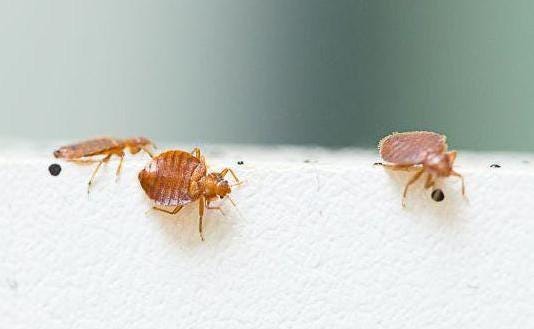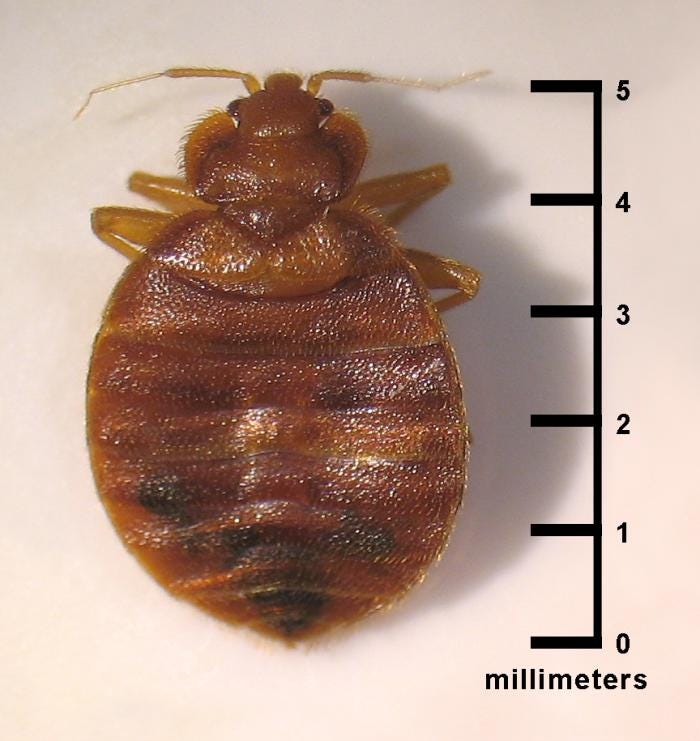The Hidden Threat in Your Mattress: What You Need to Know
Written on
Understanding the Bed Bug Dilemma
Bed bugs have made a significant comeback worldwide over the past twenty years, as highlighted in a recent scientific analysis. These pests, once deemed a concern primarily for developing nations, now infiltrate every segment of society. A striking example occurred in Paris in November 2023, when Deputy Mayor Emmanuel Grégoire addressed the media, stating, "No one is safe," according to a report by Vox.
In the United States, these pests have been discovered in luxury hotels and resorts, with the Centers for Disease Control and Prevention (CDC) noting that their presence is not linked to the cleanliness of the environments they inhabit. If you’ve ever awakened at night with irritated skin and spotted tiny creatures scurrying away at the edge of your mattress upon turning on the light, you are certainly not alone. Many patients in my dermatology clinic have expressed distress over mysterious red welts that appear each morning, often accompanied by relentless itching.
Statistics reveal that one in five Americans has either experienced a bed bug issue at home or knows someone who has. Orkin, a pest control firm, recently published its 2024 ranking of the most affected cities in the U.S., with Chicago topping the list for the fourth consecutive year:
- Chicago
- New York
- Philadelphia
- Cleveland
- Los Angeles
- Detroit
Interestingly, these pests are not limited to urban areas; the Southeastern region accounts for 30% of bed bug infestations nationwide, while Ohio is recognized as the state with the highest prevalence.
The Tiny Vampires
Bed bugs are small, wingless, and flat insects that range in color from reddish to dark brown, measuring between 1 to 7 mm (about ¼ inch at their largest), making them roughly the size of an apple seed. They use sharp mouthparts to pierce human skin and extract blood, often leaving behind an itchy, red mark. Nocturnal by nature, they feast on unsuspecting sleepers, injecting an anesthetic and anticoagulant during feeding, which can make the bites go unnoticed for a while. A single feeding can last anywhere from 10 to 20 minutes.

Their fondness for bedrooms stems from their attraction to the carbon dioxide (CO2) that humans exhale. They often hide in cracks of walls, floors, and headboards, emerging during the early morning hours when people are in deep REM sleep and exhaling higher amounts of CO2.
Bed bugs can infest various locations, including hotel rooms, cruise cabins, shelters, dormitories, apartments, and even modes of transportation like trains and buses. Several of my college-age patients who furnished their apartments with pre-owned mattresses have unwittingly invited bed bugs into their homes. Infestations can escalate rapidly, as females can lay one to five eggs daily, accumulating up to 500 eggs in their lifetime.
“It only takes one pregnant bedbug to initiate an infestation in an entire building,” stated Michael Scharf, PhD, a Professor of Urban Entomology at Purdue University.
Signs of an Infestation
The most apparent indicators of a bed bug infestation include bite marks in linear clusters or zigzag patterns, which can appear red, slightly swollen, and itchy. These reactions may manifest within an hour or take as long as two weeks, varying by individual. Insomnia, anxiety, and itching are often the first signs of a bed bug problem.
“Bite reactions can range from no visible signs to mild marks or even severe allergic reactions,” according to the CDC. While bed bugs are not generally considered a health hazard, allergic reactions to multiple bites may necessitate medical attention. It’s essential to avoid scratching the bites to reduce the risk of secondary infections.
Why Bed Bugs Persist
Approximately 70% of pest control professionals agree that bed bugs are among the most challenging pests to eradicate. It’s no wonder these resilient insects have survived for over 3,500 years, with evidence of their existence found in Egyptian tombs. Several characteristics give them an edge:
- Bed bugs can endure long periods without a host, surviving for up to a year without a blood meal.
- They are skilled at hitchhiking, often attaching themselves to items like backpacks, luggage, and purses, enabling them to travel easily. They can cover over 100 feet in a single night but typically reside within eight feet of a sleeping person.
- They can withstand extreme cold, entering a hibernation-like state during deep freezes and reemerging when temperatures rise.
- Their ability to conceal themselves allows them to hide in mattress seams, folded sheets, behind headboards, and within soft luggage and furniture. Often, insecticides fail against these hidden pests.
Additionally, bed bugs possess the ability to detoxify the chemicals and toxins ingested from their blood meals, rendering many insecticides ineffective.

Identifying an Infestation
To effectively address a pest issue, it’s crucial to identify the specific pest involved. Unfortunately, this can be complicated, as studies indicate that over 70% of bed bug infestations are initially misdiagnosed as flea infestations. Pest control professionals report that bed bugs are accurately identified in only 16% of cases. The bugs exist in one of three life stages: egg, nymph, or adult. Here’s what to look for:
- Dark spots on sheets resembling the size of a period are droppings from bed bugs.
- Reddish stains on your mattress and linens signify crushed bugs.
- Pale yellow eggs, approximately the size of a pinhead, and egg shells may also be present.
- Look for yellowish, papery exoskeletons left behind during the molting process.
- A sweet, musty smell can stem from secretions from the bed bug’s glands.
Live bed bugs can be spotted, so it’s essential to inspect mattresses and bed frames closely, using a flashlight if necessary.
While anyone can experience a bed bug infestation, travelers are at a heightened risk due to frequent hotel stays and exposure to shared upholstered seating in places like buses, hotels, and airplanes. It’s advisable for travelers to meticulously check hotel rooms for signs of bed bugs, elevate luggage and backpacks off the floor, and store them away from the bed and walls. The bathroom and counters are typically the safest places. Upon returning home, inspect luggage again and store it outside the bedroom, preferably in hard-sided cases, as bed bugs are less likely to cling to rigid materials.
What to Do if Infested
Experts recommend the following steps if you suspect a bed bug infestation:
- Immediately seal potentially infested items in heavy-duty plastic bags. Keep contaminated items separate from clean ones to prevent spreading.
- Heat is crucial for exterminating bed bugs; they and their eggs perish at 122°F (50°C). Wash all clothing and bedding at the highest temperature the fabric can tolerate, using regular laundry detergent.
- Dry all items on the highest heat setting for a minimum of 30 minutes, ideally 60 minutes.
- For items that cannot be washed, place them in the dryer on high heat for 30–60 minutes.
- Consider dry cleaning delicate items, informing the cleaner about the bed bug issue beforehand. Dry and steam cleaning will effectively kill bed bugs in fabrics.
- After drying, immediately store clean items in new, sealed plastic bags until your living space has been thoroughly treated and inspected.
While many home remedies circulate online, including mothballs, dryer sheets, essential oils, baking soda, and tea tree oil, it’s important to note that most are not scientifically supported. Given their resilience, consumers are strongly advised against using chemicals for bed bug control, as many insecticides available to the public may not effectively eliminate them, especially since these pests often evade treatment by moving to other rooms until the chemicals dissipate.
If, after decluttering, cleaning, and sealing off hiding spots, the problem persists, it may be time to seek professional assistance. Some experts suggest contacting pest control at the first signs of an infestation.
For skin rashes and bites, apply an over-the-counter corticosteroid cream to alleviate inflammation and itching. Anti-itch creams like calamine or Sarna lotion can also provide relief. Many patients have found oatmeal baths or compresses made from a baking soda and water mixture soothing; mix three parts baking soda with one part water, apply it to your skin, and leave it on for 20 minutes before rinsing off. Alternatively, adding half a cup of baking soda to a bath can be effective.
Oral antihistamines like Benadryl and over-the-counter pain relievers may be beneficial for moderate to severe itching and discomfort.
Additionally, consider the colors of your bedroom decor. It turns out that bed bugs have color preferences; a study published in the Journal of Medical Entomology found that they gravitate toward red and black while avoiding green and yellow.
The first video titled "News 4 Investigates: The danger lurking in your mattress" discusses the hidden risks associated with bed bugs in your sleeping environment.
The second video, "Millions of Microbes Are Living in Your Mattress," explores the unseen microbial life that can exist in your mattress, highlighting the importance of cleanliness and awareness.